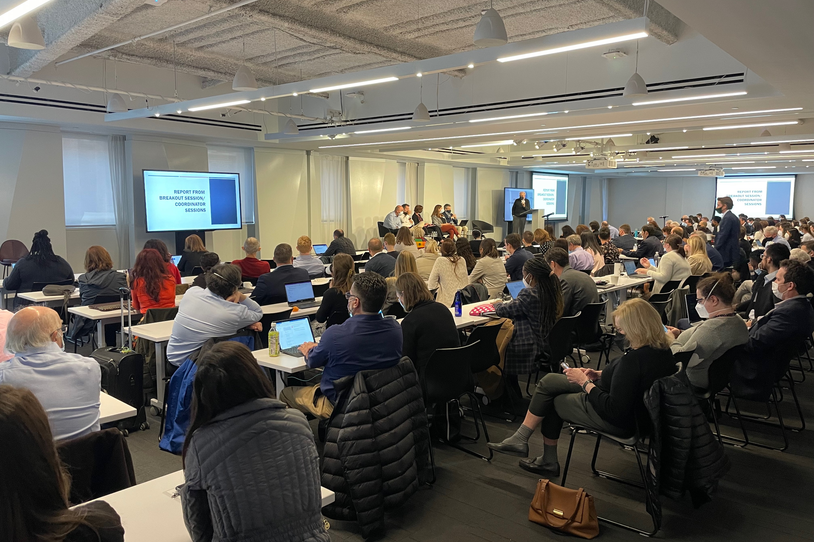
Nearly 250 people — investigators, coordinators, study participants and industry partners — gathered in New York City in late April for the Parkinson’s Progression Markers Initiative (PPMI) Annual Meeting. Representatives from 14 countries were in attendance for the two-day meeting, the first one in person since 2019.
As our landmark PPMI study enrolls participants as part of its massive expansion, study leaders came together to discuss challenges and opportunities for enrollment; scientific findings coming out of the study; and strategies to maintain progress. The study has evolved and continues to advance, activating new sites and implementing technology with ambitious goals to enroll 4,000 participants at medical centers across the globe and as many as 100,000 volunteers online.
PPMI is open to anyone over age 18 in the U.S. Join the study that could change everything. Outside the U.S.? Medical centers in nine other countries are recruiting participants with certain connections to PD. View a list of sites.
“We are in awe of participants and their commitment to the study,” said Sohini Chowdhury, The Michael J. Fox Foundation Deputy CEO and Head of Research, in her welcoming remarks. “PPMI cannot exist without volunteers. They are the motor — and you all are the fuel that keeps PPMI going.”
Here we share highlights, progress and scientific findings coming out of PPMI.
Annual Meeting Highlights Study Progress
“We have accomplished a lot, despite difficulties in the past few years,” said PPMI Principal Investigator Ken Marek, MD, of the Institute for Neurodegenerative Disorders, in his opening remarks. “The biggest contribution of PPMI is the data and biosamples that have enabled therapeutic efforts to move forward.”
Before diving into sessions, Dr. Marek introduced Daniel Weintraub, MD, of the University of Pennsylvania, who paid homage to one of PPMI’s founding members, John Trojanowski, a legendary neuroscientist who died earlier this year.
The meeting began by highlighting a decade of accomplishment and sharing an enrollment update. In the past 12 months, PPMI saw an uptick in data downloads, biosample requests and an increase of publications in scientific literature — a testament to the value of the study. Today, 1,147 participants are visiting medical centers for study visits while more than 20,000 are contributing data online.
A focus of the meeting was the study’s goal to recruit 2,000 people at risk for Parkinson’s disease (PD). Enrolling people at risk for Parkinson’s can help scientists understand who develops Parkinson’s, who doesn’t and why. This information could point to ways to predict and diagnose the disease earlier and to develop and test therapies to prevent Parkinson’s.
Dr. Marek and study leaders reported that current strategies to recruit these individuals are working, but many more are needed. Data from PPMI is indicating that smell loss may be one of the most important signals of Parkinson’s risk. The study leaders are working to get scratch-and-sniff tests out to thousands of people to determine risk and eligibility in PPMI.
Sneha Mantri, MD, of Duke University, shared how the study team and sites are implementing strategies (e.g., educational lectures, community events) to reach groups that are typically underrepresented in research. A more inclusive PPMI will broaden its insights and the application of findings from the study.
Investigators Share Scientific Results
Throughout the meeting, investigators and industry partners shared findings and discussed proposed activities toward better understanding, measures and treatment of Parkinson’s disease.
“PPMI has really driven a lot of research in the field,” said Danna Jennings, MD, senior medical director at Denali Therapeutics.
- A PPMI co-principal investigator, Tanya Simuni, MD, of Northwestern University presented findings that subtle motor and non-motor signs of disease may precede diagnosis in people who carry a LRRK2 gene mutation. She highlighted the need to explore more measures and data over time to help predict the onset of PD.
- Study leadership shared progress toward a test to diagnose Parkinson’s. An alpha-synuclein seeding assay (a kind of lab test) measures how the Parkinson’s protein alpha-synuclein clumps in spinal fluid. A team led by scientists in New York used PPMI samples to compare three different assays in three laboratories finding similar results and showing reproducibility of this tool that may help detect Parkinson’s.
- One “hot topic” that came up in multiple sessions was the microbiome. At the meeting, David Standaert, MD, PhD, at the University of Alabama at Birmingham, discussed his work reviewing the relationship between genetics and changes in the gut. He questioned: Could PPMI add new assessments or collect additional samples to make sure scientists are getting the clearest picture of disease?
Papers Outline Recent Scientific Findings Out of PPMI
As study leaders shared progress, PPMI data — downloaded more than 10 million times by researchers — continues to fuel discovery. Here we share some of the latest insights from PPMI data analysis.
- Economy Changes and Stress Impact Mood, Health and Brain: Scientists from Sweden used PPMI data to examine the impact of changes in the stock market. The stock market is a proxy measure for economy and society stresses. These scientists found stock market volatility linked to mood changes, alcohol intake, higher blood pressure and even changes in certain brain areas.
- Regular Physical Activity Slows Some Parts of Parkinson’s Progression: Researchers in Japan reviewed PPMI data to study the impact of physical activity and exercise. Regular physical activity improved posture and walking and cognitive processing speed in people with Parkinson’s. It also helped individuals stay more independent and able to complete daily tasks.
PPMI centers around common themes: urgency, iteration and collaboration. As study leaders head back to their homes around the world, they continue this mission with renewed energy to keep progress moving forward.
You can play a role in PPMI, whether you have Parkinson’s or not. Join the study that could change everything.